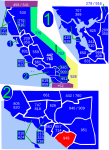Laguna Woods, California

Laguna Woods (Laguna, Spanish for "Lagoon") is a city in Orange County, California, United States. The population was 16,192 at the 2010 census, down from 16,507 at the 2000 census with a median age of 78. About ninety percent of the city consists of Laguna Woods Village, a private gated retirement community, formerly known as Leisure World. The other ten percent consists of businesses and the city hall, which are available to the public. Incorporation efforts in the late 1990s were largely driven by the need for residents to have a stronger voice against the prospective construction of an international airport at the nearby decommissioned Marine Corps Air Station El Toro. The airport proposal was defeated and the land in question has been tabbed for development as the Orange County Great Park.
Excerpt from the Wikipedia article Laguna Woods, California (License: CC BY-SA 3.0, Authors, Images).Laguna Woods, California
El Toro Road,
Geographical coordinates (GPS) Address Nearby Places Show on map
Geographical coordinates (GPS)
| Latitude | Longitude |
|---|---|
| N 33.609166666667 ° | E -117.73277777778 ° |
Address
Geneva Presbyterian Church
El Toro Road
92637
California, United States
Open on Google Maps







